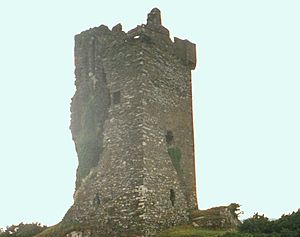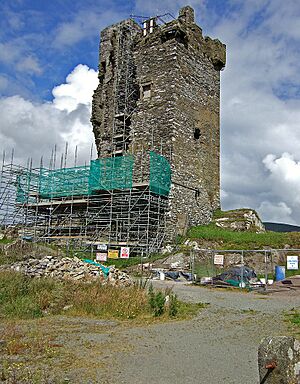Castle Donovan facts for kids
Castle Donovan (which in Irish is Caisleán Uí Dhonnabháin) is also known as Castledonovan or O'Donovan's Castle. It is an old Irish tower house, a type of castle, found in a valley near Drimoleague. This castle was once the main home for a part of the O'Donovan family, called Clann Cathail, during the 1500s.
The castle was originally called Sowagh (or Sooagh, Suagh). It got the name Castle Donovan after a new official grant from James II of England in 1615. The castle is about 60 feet tall. It stands on a large rock next to the River Ilen.
Building Castle Donovan
People believe that Donal of the Hides, who was a leader of the Clancahill family from about 1560 to 1584, either built or added a lot to the castle. His son, Donal II O'Donovan, later fixed or changed the castle even more. However, by then, the family was no longer living there. It is thought that Donal of the Hides had already moved his family. They moved to Rahine Manor on the coast to protect their interests related to the sea.
What Happened to the Castle?
Stories say that Oliver Cromwell's soldiers badly damaged the tower in the late 1640s. They blew it up with gunpowder. This was because Donal III O'Donovan joined the side of the House of Stuart and was involved in a big conflict in Ireland in 1641. The castle has been empty ever since.
In 1834, a traveler named Philip Dixon Hardy wrote about his visit to the "vale of Castle Donovan" in 1828. He described the area as very wild and lonely. He also drew a picture showing some of the smaller buildings that were once around the castle.
Castle Donovan Today
The wall that once surrounded the tower, called a bawn, and other buildings are now gone. But more than two-thirds of the main tower still stands. The explosion in the 1600s only left a small mark on one corner. However, it caused huge cracks in the stone. This made the building unsafe.
Over 200 years later, the entire western wall and most of the southern wall fell down. Only the spiral staircase remained. Between 2001 and 2014, the Office of Public Works, a government group that takes care of old buildings, worked to preserve the castle. Today, Castle Donovan is a protected National Monument.



